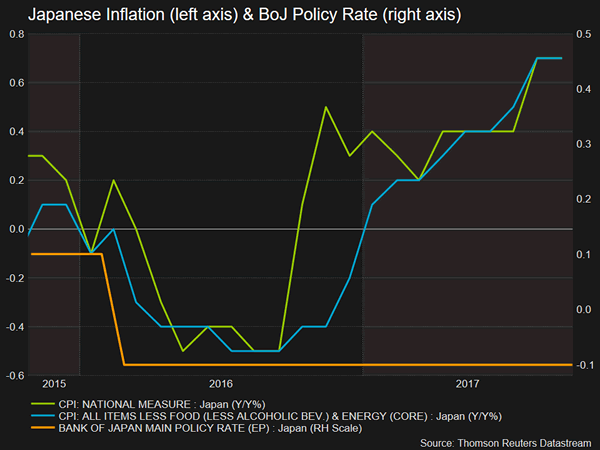The Bank of Japan will be tomorrow completing its two-day meeting on monetary policy. With inflation remaining well below the central bank’s 2% target – headline and core inflation grew by 0.7% y/y in September – the BoJ is not expected to reverse course from its ultra-easy monetary policy stance.
Market participants anticipate the BoJ to maintain the 0.1% fee charged on a portion of commercial banks’ reserves held with the central bank as well as keep its target for the 10-year Japanese government bond yield around 0%. It is also likely to maintain its purchases of exchange-traded funds and real estate investment trusts at current levels.
The base case scenario is that there won’t be much market reaction to the BoJ’s decision, given of course that the outcome does not significantly deviate from expectations. There is speculation however that the central bank could cut this year’s inflation forecast of 1.1%. The BoJ has also numerous times in the past pushed forward its time frame for achieving its 2% inflation target – it currently aims to accomplish that "around fiscal 2019." Should the bank indeed project a weaker outlook for inflation, then dollar/yen could head higher. The pair touched a three-and-a-half-month peak of 114.44 at its highest on Friday following the release of stronger-than-expected third quarter GDP figures out of the US. The area around this level, which also encapsulates a couple of peaks from the recent past, could act as a barrier to the upside, with the range around the 114 handle – a potential psychological level – also having the capacity to act as resistance.

A hawkish take by the BoJ that would push dollar/yen lower is unlikely, especially in light of the fact that dovish-perceived members have recently joined the bank’s board; in the previous meeting new board member Goushi Kataoka dissented, favoring additional stimulus. If dollar/yen moves lower, then that’s more likely to do with figures for household spending, employment and industrial production for the month of September all due tomorrow out of Japan (with US-related developments pushing the pair lower also not to be ruled out). A decline could see the pair finding support around the 113 mark, this being an area of congestion recently.

In the bigger picture, the BoJ is likely to stick to its broader outlook of a gradual rise in inflation and moderate growth.
BoJ Governor Haruhiko Kuroda’s term ends in April. Prime Minister Shinzo Abe coming strong out of elections earlier this month is seen as increasing the chances of Kuroda being reappointed as BoJ chief for a second five-year term, something which would likely translate into massive stimulus remaining in place further ahead. Given the different path monetary policy is taking in Japan versus elsewhere in the world – and perhaps most notably in the US – this is supportive of a weaker yen relative to other currencies in the medium- to longer-term.
The recent rally in equities in the world’s third largest economy is also noteworthy – the Topix and Nikkei 225 currently stand at their highest levels since 2007 and 1996 respectively.
Later in the week, the forex markets’ focus would turn to the Fed meeting (November 1) and the Bank of England meeting (November 2) with the latter one being the one that is seen as having the highest odds of reflecting a shift in monetary policy.












